Gourami: description, types and care
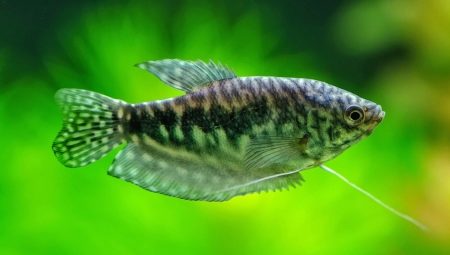
Gourami are unpretentious labyrinth fish. They are distinguished by their peaceful and friendly nature. The aquarium with them looks unusual and bright, it can be placed in any room: in the living room, bedroom and nursery. You can admire the fish for hours, they have interesting behavior and beautiful colors. And caring for them will not cause difficulties even for a novice aquarist.
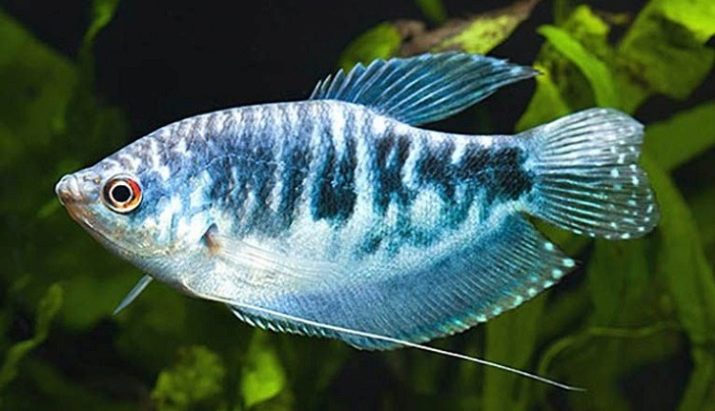
Peculiarities
Gourami are aquarium fish of the Macropod family. Their homeland is the fresh water bodies of Southeast Asia. In their natural environment, they can be found both in stagnant waters and in flowing rivers, and some species can even be found in the brackish tidal zone. Unpretentious and rather tenacious, they can do without water for up to 6-8 hours.
An interesting feature of this species is the presence of a labyrinth organ. It is located in the region of the gills and is a thin plate covered with a network of vessels. Due to the labyrinth, gourami can breathe atmospheric oxygen, they do this by swallowing air with their mouths near the surface of the water. Translated from Javanese "gourami" means "a fish sticking its nose out of the water." This feature must be taken into account when transporting fish. A bag or container of gourami should not be filled to the brim with water; a space should be left with air.
Depending on the species, the size of gourami usually reaches 5 to 15 cm. But in an aquarium, most often they do not grow more than 10 cm. The body shape is elongated, flattened from the sides. The pectoral fins are elongated and resemble a mustache; in gourami, this is a kind of organ of touch.With it, the fish probes unfamiliar objects in the aquarium, snails and new fish. It happens that such a mustache can break off, there is nothing wrong with that, they will definitely grow back. Thanks to them, these aquarium fish are called filament gourami.
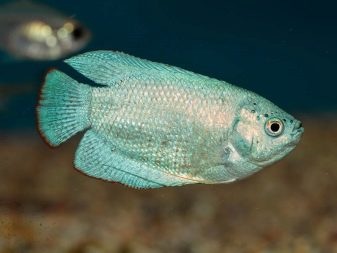
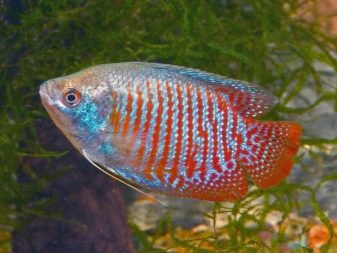
Varieties
There are many varieties of gourami, each of which has an original color and individual characteristics. Below is a description of all types.
Brown
A chain of black spots runs along the gray abdomen. Due to this color, similar to snake skin, and a more elongated body, this species is also called serpentine.
Differs in rather large sizes, in the aquarium they reach 15 cm.
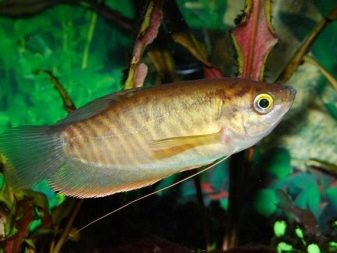
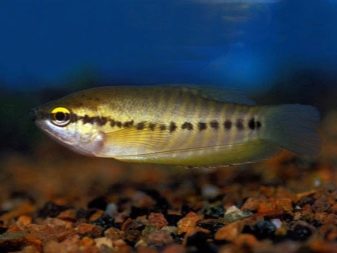
Pearl
A very beautiful view: light specks, similar to pearls, are scattered over the silvery body. During the spawning period, it changes color, red and orange tints appear on the abdomen.
When kept in a spacious tank, pearl gourami can grow up to 13 cm in length.
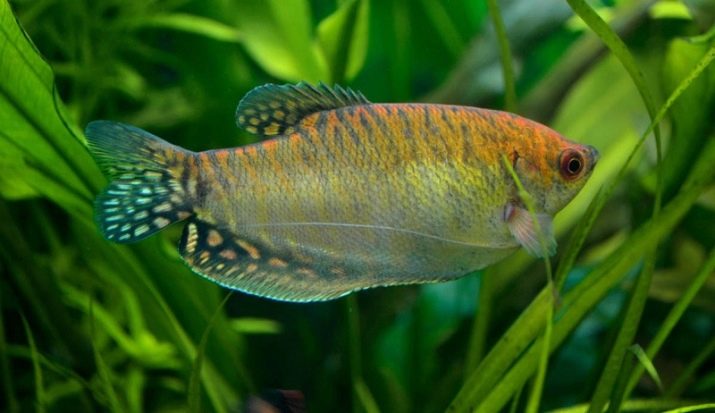
Marble
There are black spots on the blue abdomen, forming a beautiful marble pattern. One of the most unpretentious species, resistant to infectious diseases. The maximum length is 14 cm.
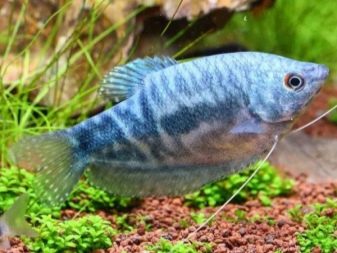
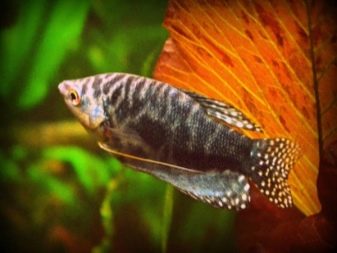
Lunar
This species got its name from its silvery color with an unusual pearlescent tint. The fish seems to emanate a soft moonlight. Lunar gourami will not only decorate the aquarium, but also keep it clean.
These fish are considered good cleaners.
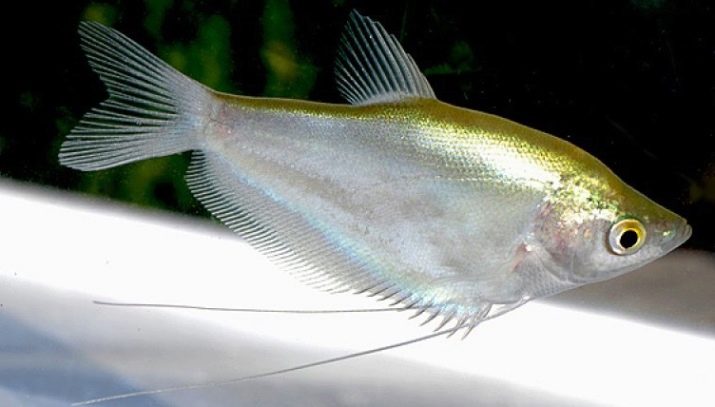
Rainbow
One of the most striking species, the abdomen casts blue, red and orange. Males are sometimes aggressive towards females, they can drive them around the aquarium, but they usually do not cause serious injuries. In an aquarium, rainbow gourami grow up to 8 cm.

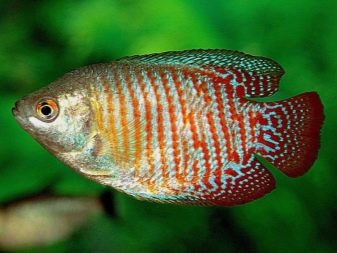
Honey
It has a rich yellow color, which changes during spawning to fiery red. It belongs to the small species of gourami - it grows up to 6 cm.

Spotted
This species has a silvery body with light purple tints. There are two dark spots on each side. Spotted gourami is also called common, it is one of the most common species. In an aquarium, it grows up to 13 cm.
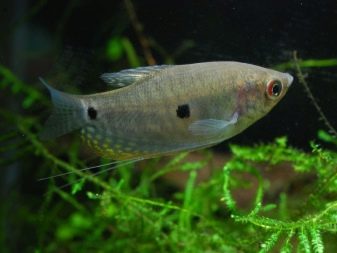
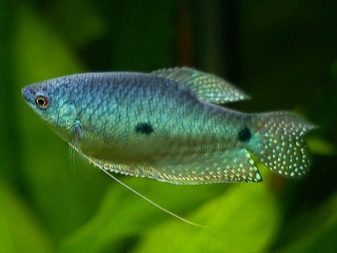
Blue
The name comes from the beautiful blue tide. The abdomen is decorated with barely noticeable stripes and two black spots. Blue gourami has an active character, it is unpretentious and easy to spawn.
It is recommended to keep it for novice aquarists. The maximum size is 10 cm.
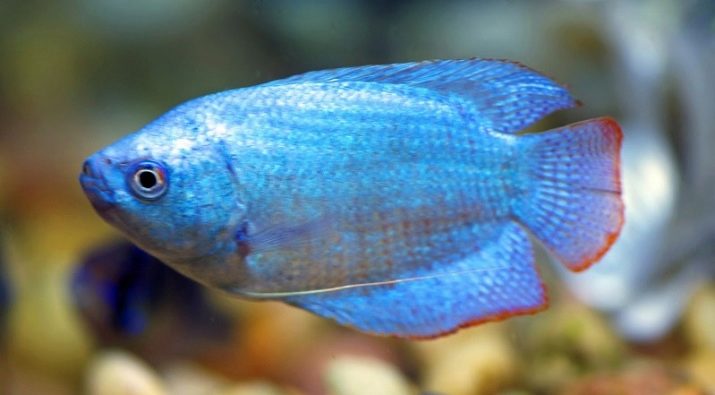
Yellow-red
This species is similar in color to the honey gourami, but there is still a difference between them. Yellow-red gourami are more active and large in size - they grow up to 14 cm.
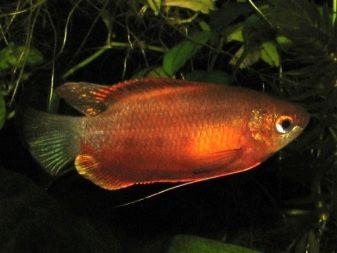
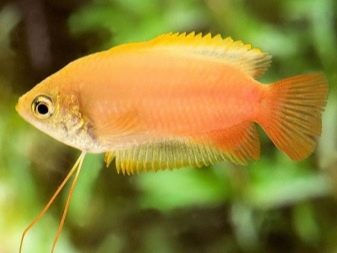
White
The gourami of this species have a uniform white-silver color. Likes to swim in the upper layer of water. In the aquarium, he is constantly busy with some business: builds nests, bites plants, cleans decor items. It can grow quite large - up to 17 cm.

Dwarf (pumila).
They resemble cockerels in appearance, but have shorter fins. On the brown abdomen, blue and red scales are beautifully cast. They are also called sparkling. Dwarf gourami are very miniature - they grow no more than 4 cm in length.
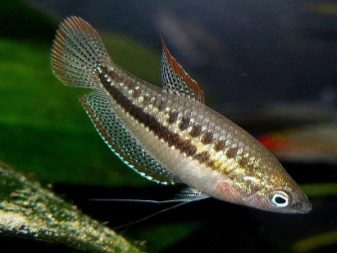

Gold
This species has a bright yellow shining color - the fish looks like an ingot of gold. Some people like to compare it to the sun more, so it has another name - solar gourami. It can be confused with yellow-red gourami, but gold has a richer color. Fish are shy, so they need enough cover. The maximum size is 14 cm.
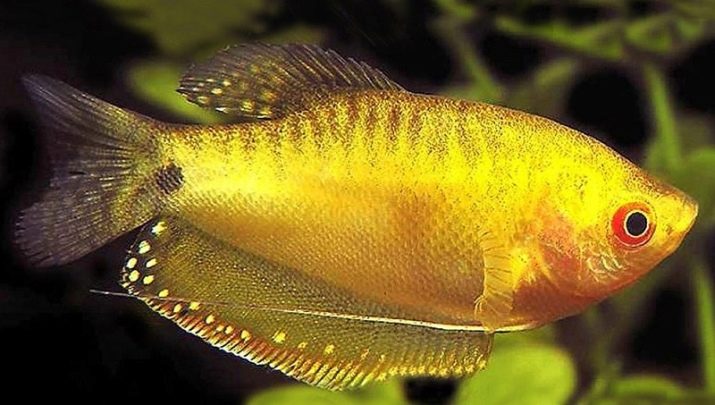
Kissing
This species received such an interesting name due to its unusual behavior. Sometimes you can see two "kissing" fish, but this is not courtship, but rather a matter of hygiene. Their teeth are close to their lips, and the fish just help each other cleanse. Kissing gouramis have a pink color with a slight silvery tint, and the maximum length of an individual is 16 cm.
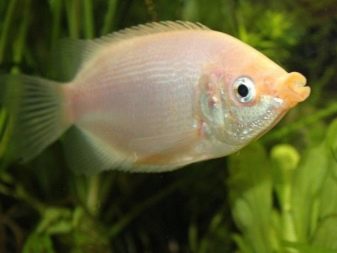
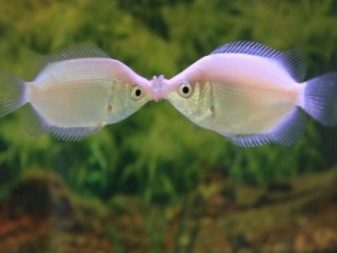
Chocolate
Gourami is dark brown in color with light stripes. This species is more demanding in content. Fish prefer live food, and despite the miniature size - only 6 cm, they need a fairly spacious aquarium.
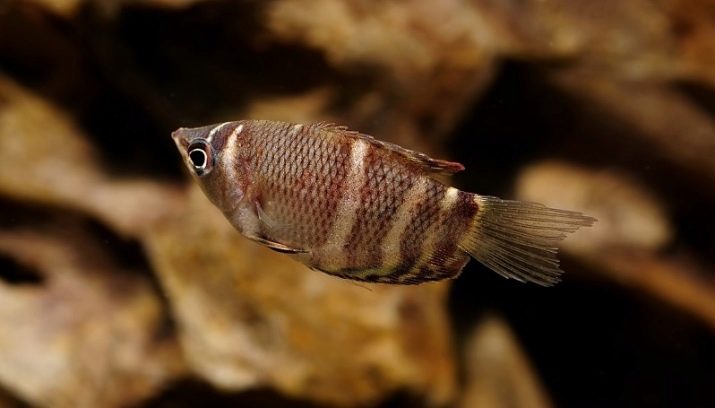
Grunt
The abdomen is bright in color with a greenish tint; dark stripes run along the body. Taking care of the female, the male makes peculiar sounds similar to grumbling, from which this gourami got its name. The grunting gourami grows up to 8 cm.

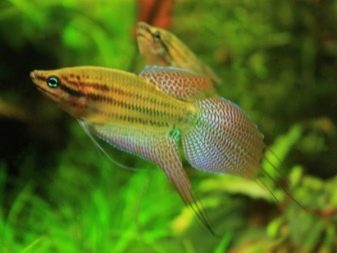
Tiger
An interesting color of the abdomen, similar to the skin of a tiger, is light brown with black stripes. This species occurred as a result of crossing between marble and gold gourami. The maximum length in a spacious aquarium is 10 cm.
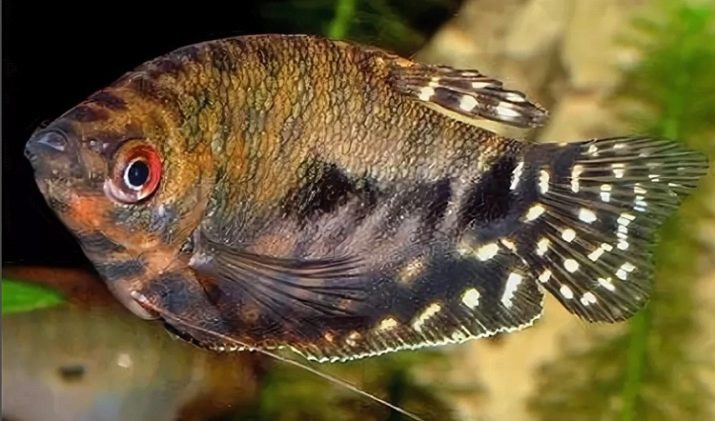
Vailanta
This is a type of chocolate gourami. Females are very richly colored, the abdomen shimmers with red, purple and blue hues. Males are more modest, they have a gray body with white transverse stripes.
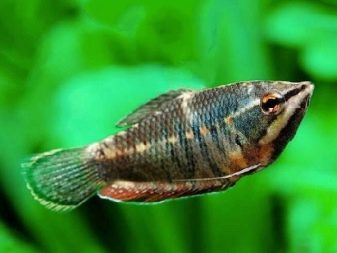
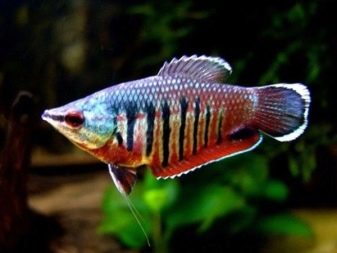
Giant (real)
These are the largest fish from the labyrinth, in aquariums they grow up to 40 cm. The color of the abdomen is silvery with dark stripes, which fade with age. The fish has a large forehead and powerful jaws.
A giant gourami needs a large aquarium - from 500 liters.
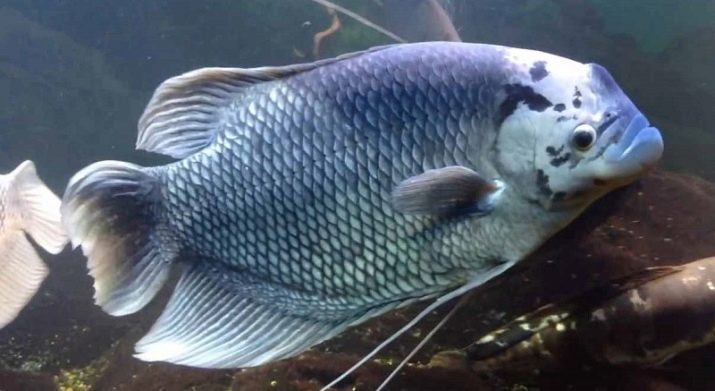
Compatibility
Gourami are generally peaceful, do not show aggression towards other fish species. But skirmishes can occur between adult males, especially in cramped aquariums. Therefore, it is recommended to keep a school of these fish, consisting of 1 male and 3-4 females. Several types of gourami can be accommodated together, such as marble, pearl and honey.
As neighbors for them, it is worth choosing the same peaceful fish, ideal for:
- minors;
- zebrafish:
- tetras;
- iris;
- platies;
- neons;
- swordtails;
- lalius;
- catfish;
- macropods;
- mollies;
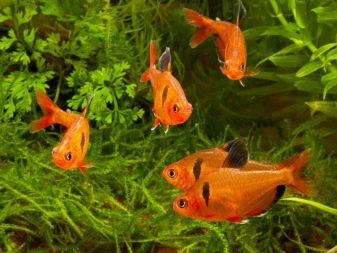
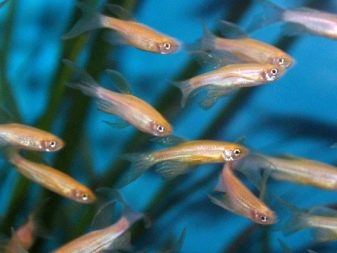
Limited compatibility in gourami with the following species:
- scalars tend to show aggression during spawning;
- barbs can nibble on beautiful gourami fins;
- Labeos love loneliness and defend their territory;
- guppies can be attacked by large fish, so they can only be kept with miniature gourami;
- gourami may have conflicts with battles, so it is necessary to monitor the behavior of the fish.
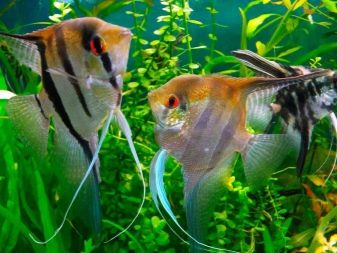
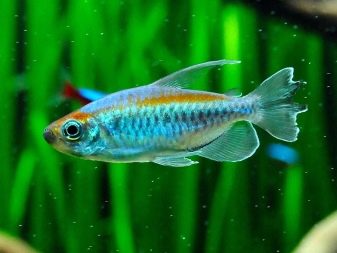
The listed species can become good neighbors for gourami, but only if the aquarium is spacious enough and there are many vegetable shelters in it. If the fish are comfortable, then peaceful coexistence is possible.
There are also fish that the gourami will definitely not be able to make friends with:
- cockerels have a hot temper;
- cichlids - these predators, they will drive gourami;
- Astronotuses can easily cripple weaker fish;
- discus are very conflicting, especially during the spawning period;
- complete incompatibility with goldfish.
Some aquarists still keep gourami with medium-sized cichlid species.
This is acceptable if the size of the fish is approximately the same and they are kept together from an early age.
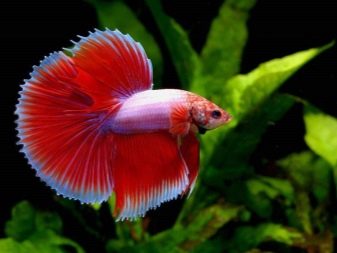
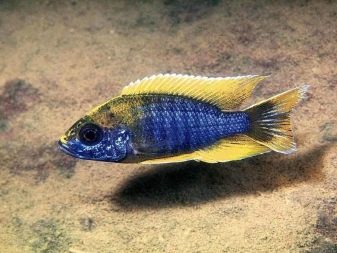
Growing conditions
Despite the fact that gourami are unpretentious, they need to create a comfortable environment. It is necessary to properly equip the aquarium, adjust the necessary water parameters and feed them well. If the fish are healthy and "satisfied" with the living conditions, their color will be bright, they look spectacular in the aquarium and attract the eyes.
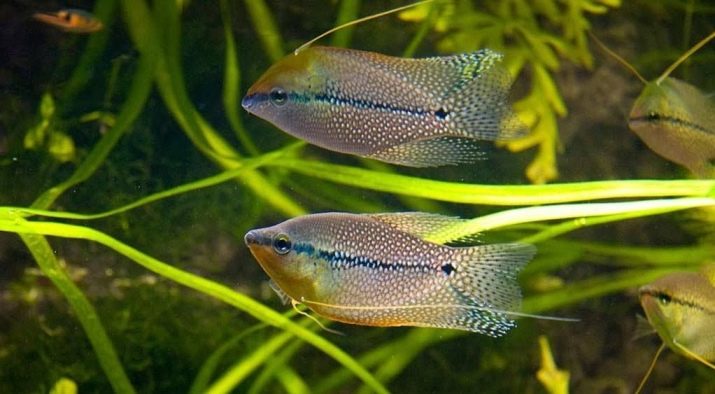
Aquarium requirements
For the successful keeping of fish, choose an aquarium of a suitable size. For a flock of 3 gourami, a 50 liter tank is required, but for some species there are exceptions:
- 30 liters will be enough for honey, dwarf and rainbow gourami;
- 80 liters will be needed by spotted gourami;
- 100 liters are necessary for kissing gourami;
- 500 liters to contain the giant gourami.
Place the aquarium away from direct sunlight, radiators and noise sources. A loud TV can cause stress among aquatic residents. The container must be covered with a cover glass, since the fish can jump out of the aquarium.In addition, the cover will prevent the air above the water surface from getting too cold.
Gourami rise to the edge of the reservoir to swallow a portion of oxygen, and strong temperature changes can damage their labyrinth organ.
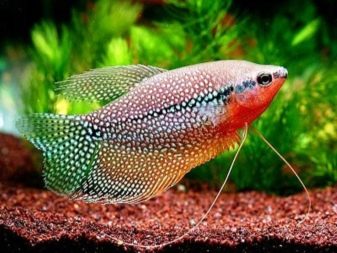

Water
Gourami adapt well to different conditions, but for a comfortable and long life, the water parameters in the aquarium should be as follows:
- temperature - 22-27 ° C;
- acidity - 6.0–7.5 pH;
- hardness - 8.0-15 dH.
There are some exceptions to this rule. Rainbow gourami prefers softer water (4–6.5 dH), and chocolate gourami is thermophilic - the temperature of the reservoir should be between 26–30 ° C.
For the maintenance of other species, the standard water parameters indicated above are applied.
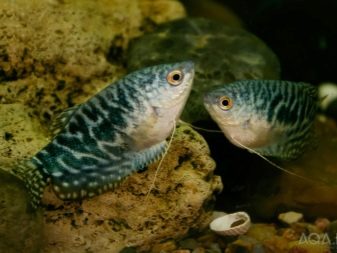
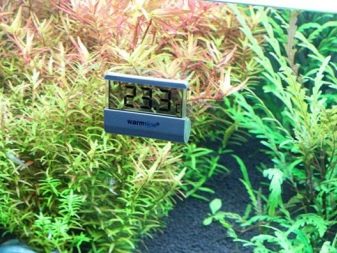
The aquarium does not need to be equipped with an aeration system. It is only necessary if the reservoir is very densely populated. But the installation of a filter is needed, it will allow you to keep the aquarium clean. The remains of uneaten food, rotting plant particles and waste products of fish - all this poisons the water. Thanks to the purification system, the water remains transparent and comfortable for the fish. When installing the filter, it should be noted that gourami prefer stagnant water, so the flow should be minimal.
Partial water changes are required weekly. 20-25% of the liquid is drained from the aquarium using a hose and a basin. Then fresh water is poured through the filter. Previously, it is allowed to stand for 2-3 days. This will equalize the temperature to a comfortable room temperature, and water can be safely added to the aquarium. A complete replacement of the aquatic environment is not required, this will stress the fish and disrupt the established ecosystem.
Such drastic measures are used only when the infection spreads in the aquarium.
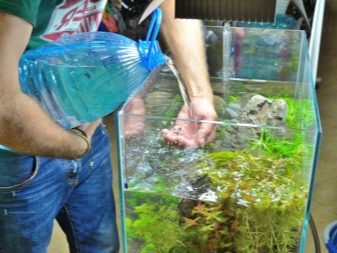

Ground and lighting
For an aquarium with gourami, it is better to choose a dark soil. Against this background, the color of the fish looks more impressive, the overflow and shine of the scales will be more noticeable. Can be used:
- coarse sand;
- small pebbles;
- granite chips.
Gourami are photophilous; to keep the fish, you will need to equip the aquarium with powerful lamps. They must be placed above the reservoir, and not on the side or below. Since the gourami spend most of their time in the upper layer of water, the light should fall from above. The lamps are turned off at night.
Daylight hours should be about 11-12 hours.
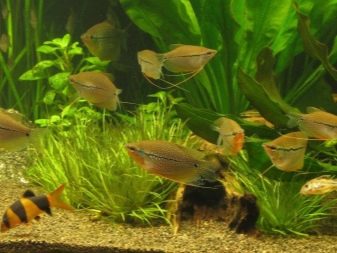
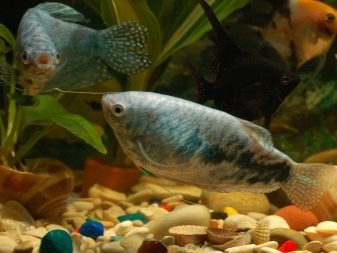
Vegetation and decor
When setting up an aquarium, you need to take care of a sufficient number of shelters. In dense thickets, fish feel calmer. You can plant a pond with the following plants:
- vallisneria - aquarium grass that grows well in bright light;
- elodea - can grow both rooted in the ground and freely floating in the water column;
- Indian fern - a beautiful plant with thin carved leaves, looks good in the background of the aquarium;
- anubias - a bush useful for the aquarium, purifies the water and saturates it with oxygen;
- Cryptocoryne is an aquatic plant with long leaves, it blooms beautifully under certain conditions;
- Riccia - floating algae, necessary for male gourami to build a nest;
- nitella is another type of floating plant.
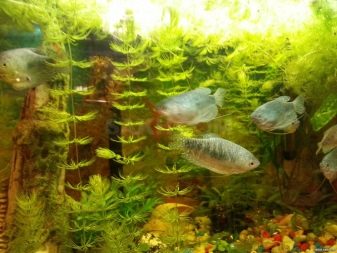

You can pick up any vegetation, the main thing is that the conditions for keeping fish and algae are similar. The aquarium is planted densely, but without fanaticism. A certain part of the space is left free in case the fish want to actively swim. It is best to plant the bushes on the sides and along the back wall of the tank, and leave the middle without plants.
At the bottom, you can put driftwood, pot shards and decorative ornaments. They should not have sharp edges. Otherwise, a gourami hurrying for cover could be accidentally injured. Several snails are inhabited in an aquarium with fish.
They are excellent cleaners and remove plaque from decorations, tank walls and plant leaves.
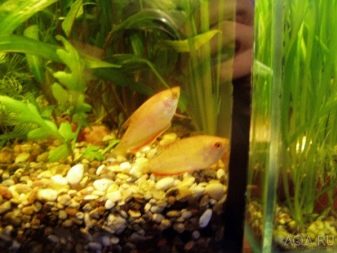
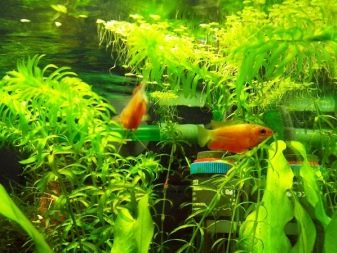
Feeding rules
Gourami are omnivorous, they gladly eat dry, vegetable and live food.But it is worth considering that their mouth is small, even in large species, so the food for the fish must be finely chopped or ground into crumbs. From dry food, it is preferable to give them flakes or chips, they stay on the surface of the water longer. Tetra produces good quality feed. For gourami, you can choose:
- TetraMin is a universal food for every day;
- Tetra Phyll Flakes contains beneficial herbal ingredients;
- TetraPro Color brightens fish colors;
- TetraPro Energy energizes fish;
- TetraPro Menu is a balanced nutritious food.
Fish are fed 2 times a day in small portions. All food should be eaten in about 2 minutes, leftovers removed. Gouramis are prone to overeating, so it is useful for them to arrange a fasting day: once a week they are not given food for a whole day.
Such a procedure will not harm health, but, on the contrary, will exclude such a common fish disease as obesity in the future.
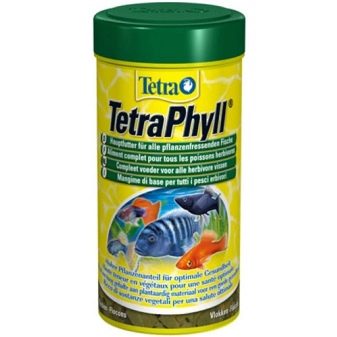
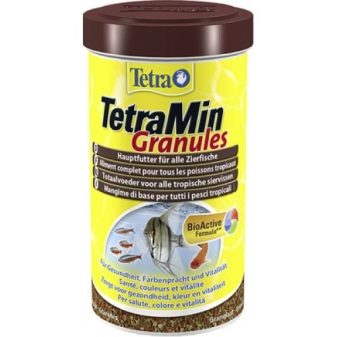
The diet must include live food. It makes the fish more resilient and their coloration brighter. A variety of small worms and larvae are suitable:
- bloodworm;
- tubifex;
- brine shrimp;
- nematode;
- meal worms.
Before feeding, live food is thoroughly washed and kept in running water. Sometimes larvae can be a source of diseases dangerous for fish. Therefore, it is best to grow them yourself or purchase them in proven specialized stores. If there are doubts about the quality of food, then it should be put in the freezer for a day. Once frozen, it will be safe.
Gourami can be given food from the table. Fish happily eat cottage cheese, processed cheese, finely chopped raw shrimp.
But you should not feed them too often with such food, you can pamper your pets no more than 1 time per week.
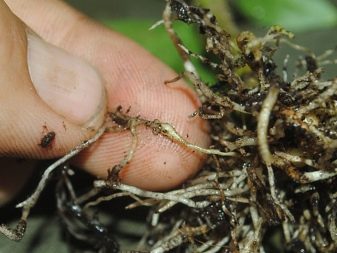
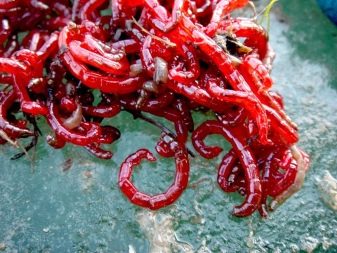
How to tell a male from a female?
Distinguishing a male from a female gourami is quite simple. There are 3 signs by which you can determine the sex of an individual.
- By the size and shape of the body. Females are smaller and rounder, males are slimmer and have a more elongated body shape.
- By color. The male is noticeably brighter, and during the spawning period, new shades may appear on his abdomen. For example, the chest of pearl gourami becomes orange-red. The exception is vailanta gourami, in this species the female's color is more beautiful than that of the male.
- The shape of the dorsal and anal fins. It is considered the most reliable way to determine gender. The fins of the female are smaller and rounded; in the male they are pointed.
You can also trace the behavior of fish. Males often chase females, while females hide in shelters. This is not a manifestation of aggression, but a peculiar way of courting a "lady of the heart".
When this happens, then it's time for the fish to spawn.

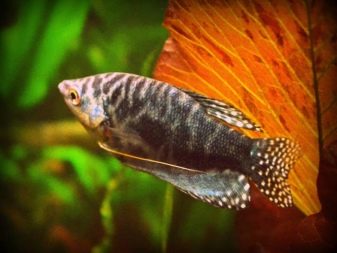
Reproduction
Before spawning, the producers must be divided by a week. The female and male are seated in different aquariums and fed with live food. At this time, you can start arranging the spawning grounds:
- choose a tank with a volume of 20 liters or more;
- in order not to cause stress in the fish, the water in the spawning grounds should not differ much from the aquarium water in all respects;
- the water temperature should be between 25-26 ° C;
- the water level is about 15–20 cm;
- it is not necessary to fill the bottom with soil, but you should put several shelters for the female, for example, a snag or pottery shards;
- be sure to place a couple of Riccia bushes or other floating plants.
The fish are launched in the evening. First, it is recommended to plant the male, and after a couple of hours - the female. Since fish in natural habitat spawn in the rainy season, they need to artificially create such conditions. To do this, replace 25-30% of the water. The fresh water temperature should be 2–3 degrees higher than in the spawning grounds.
This simple procedure will stimulate spawning, which usually begins the next morning.
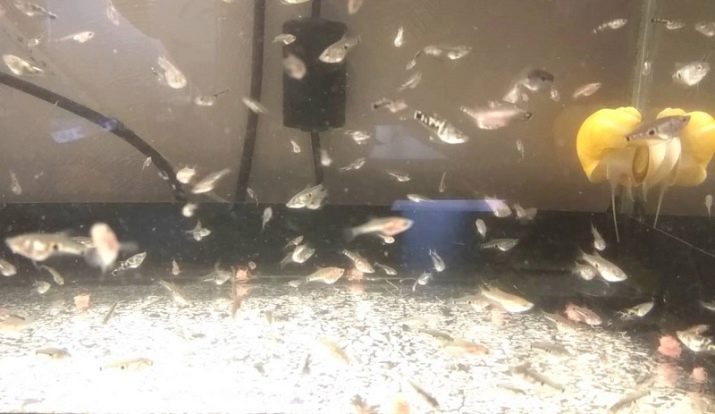
On the surface of the water, the male builds a nest similar to whipped foam. He does this from air bubbles, sometimes he can use leaves of floating plants.Spawning lasts 2–3 hours and is quite an interesting process. Gourami are not viviparous fish, they spawn. The male embraces the female with his body and fertilizes the eggs, then carefully carries them to the nest. During spawning, it is recommended to cover the sight glass and not disturb the “lovers”.
The maximum fecundity of the female is up to 2000 eggs, but most often no more than 1000 eggs appear. Not all will develop fry, most of the eggs will die. After spawning, the male can show aggression towards the female, so she is removed. The male is left for some more time, he will take care of the nest.
Larvae appear after 1–2 days. It's time to plant the male and lower the water level by 10 cm. The babies do not need additional feeding yet. All nutrients enter them through the yolk sac. Within 3 days, it gradually dissolves and fry are formed. They actively swim around the aquarium, at this time they begin to feed. They are given live dust and boiled egg yolk. As the babies grow, the food is enlarged, brine shrimp nauplii, microworm and dry flakes for fry are introduced into the diet. Gourami fry grow rapidly and become sexually mature at the age of 10–12 months.
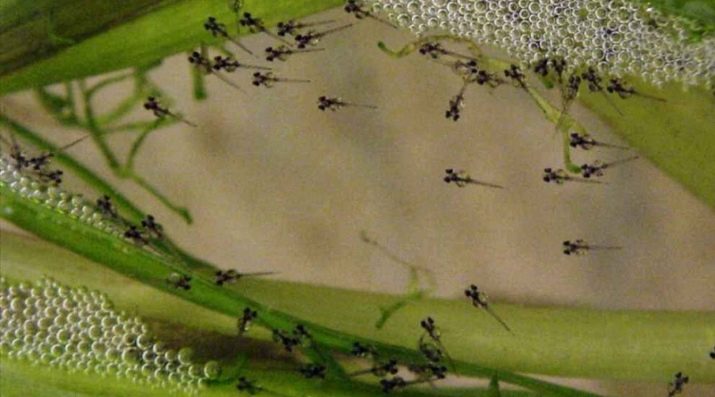
Life span
The life span of gourami is from 5 to 7 years, depending on the type and conditions of detention. In order for the fish to live as long as possible, they need to create favorable conditions:
- spacious aquarium;
- pure water;
- a large number of shelters;
- peaceful coexistence with other fish species;
- weekly feeding with live food;
- inclusion in the diet of various vitamin supplements.
If the fish are comfortable, then they can live longer. Among the gourami, there are centenarians who live for 8-9 years.
But it should be noted that fish "aged" do not spawn or do it worse.
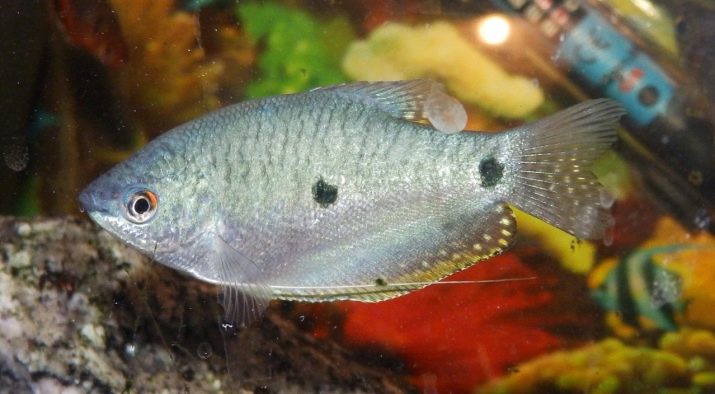
Advice
Keeping gourami is not difficult, but there are a few nuances worth paying attention to.
- It is necessary to ensure that there are few floating plants. Algae on the surface of the water can prevent gourami from swallowing air as well as blocking light from entering.
- Algae grows quickly, so it is recommended to periodically thin out the bushes. Healthy plant twigs can be sold or given to other aquarists, and all dead and rotten leaves can be thrown away.
- Remember to clean the soil when changing water. This can be done using a siphon.
- Protect the aquarium from drafts. A pond near an open window is not the best solution. Swallowing cold air can make your fish sick.
- Watch the color of the fish. The pale color of gourami indicates stress or illness.
- If strange growths or unusual spots appear on the body of the fish, then such an individual should be deposited immediately. Perhaps these are symptoms of an infectious disease.
- It is not recommended to put newly purchased fish into a shared aquarium. Better to keep them in quarantine for a week.
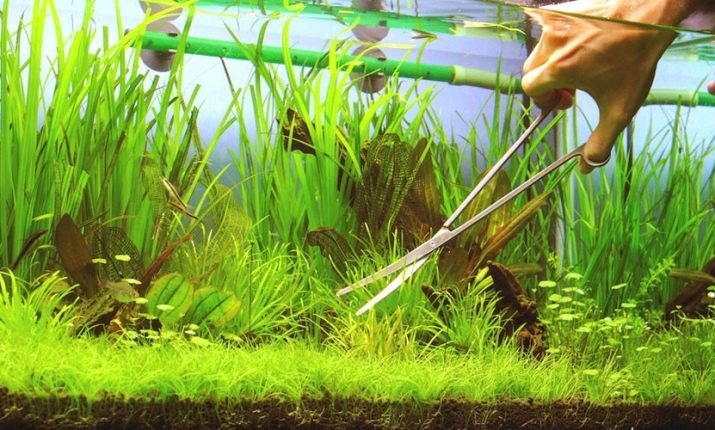
Review overview
Gourami is a fairly common "domestic" fish. Many aquarists keep and breed them successfully. The reviews are mostly enthusiastic and positive. Of the main advantages of this type, breeders distinguish:
- unpretentiousness;
- eats any food well;
- beautiful appearance;
- can grow quite large;
- peacefulness and getting along with other types of fish.
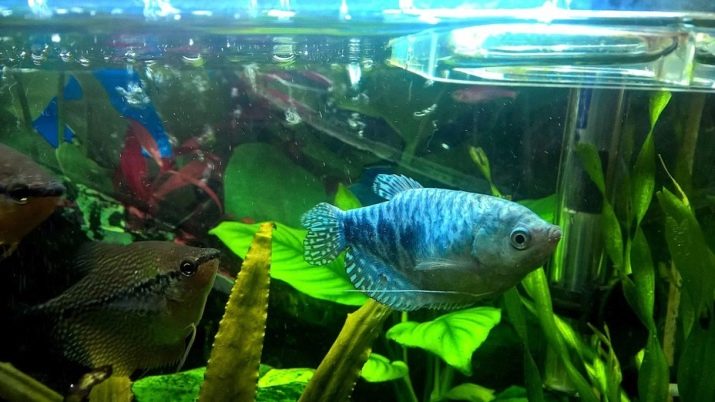
The sociability and interesting behavior of the gourami is also emphasized. If you bring your finger to the glass of the aquarium, the fish raises its whisker fins, wanting to feel an unfamiliar object. In the reviews, few people write about the cons, basically everyone praises the wonderful labyrinth fish, but they still note a few difficult points:
- intraspecific aggression between males;
- gourami sometimes jump out of the aquarium;
- the need to plant dense plants.
Some aquarists write about the difficulty of breeding them. Indeed, for the successful reproduction of fish, a separate equipped spawning grounds and special conditions are needed.It takes some effort on the part of the breeder, but the result is worth it. It is very interesting to observe the spawning process of gourami, and the fry that appear can be put up for sale.
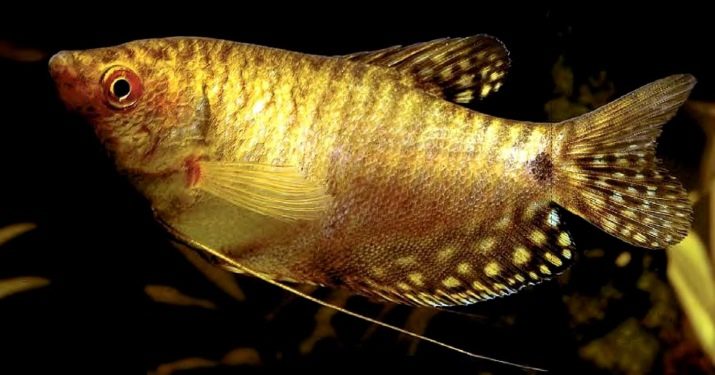
You can learn how to care for Gourami fish from the video below.








